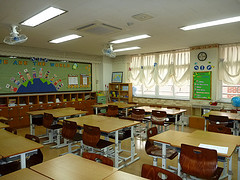

Photo by Marie (knittymarie) is licensed under CC BY 2.0
Education spending, the single largest financial obligation of state and local governments throughout the United States, is on a decline. The reduced funding is related to decreasing local tax revenues and state and federal funding cuts. The result is alarming and surely it’s time to look for new ways to resolve the problem.
Most taxpayers understand the need to pay teachers well, but few are aware of the high cost to operate old and outdated facilities. Public schools and universities in America are faced with a very critical problem – a huge backlog of maintenance, repair and upgrades that have been on hold for too long. If these facility issues are not addressed soon, the continuing expense to keep buildings, classrooms, labs and technology centers in usable condition will obligate the scant public funds available for years into the future.
A recent American School & University (ASU) sponsored webinar addressed the problem. According to statistics cited, school facility needs now exceed $365 billion in the United States. That total includes more than just construction, it also includes technology, security systems, HVAC and other equipment, plumbing, electrical upgrades and much-needed energy efficiency initiatives.
It’s hard to understand why delays are so common when one considers the following:
- School facilities are dictated by a growing student population. Officials with ASU note that the nation’s K-12 enrollment, currently at 55.9 million, will likely increase to 58.4 million by 2021. Indications are that colleges and universities will experience the same rapid growth. There is nothing to indicate a decline at any level of education.
- Deteriorating buildings are not only costly to maintain, but they also eventually become unsafe and extremely inefficient. Most no longer have the basic infrastructure needed for newer technology.
- Two decades ago, it was determined that it would take $112 billion to bring public schools into good, safe, usable condition. Today, that estimate has risen to $542 billion.
Currently, legislative leaders throughout the country are finalizing state budgets. The same discussions are happening at the federal level. Education supporters are clamoring to be heard. The justification for funding is solid, but the jury is still out on what will happen.
One alternative is, of course, the use of public-private partnerships (P3s/PPPs) for school construction. These types of engagements have been the salvation of public education systems in most other countries. There is an abundance of private capital sitting on the sidelines and there is great interest from those with capital to invest. Pension funds, union funds, investment banking groups and private-sector corporations stand ready to partner with government and fund public projects.
It’s hard to understand why there is such reluctance to test the waters with this type of funding and collaboration. Much of the country’s infrastructure in the past was built through public-private partnerships. There are examples of great success throughout the world. Unless public funding suddenly materializes, or other funding options are invented, educational facilities will eventually begin to limit the potential of students. If that happens, every citizen, taxpayer and resident in America will eventually suffer. The country’s economic vitality and its worldwide competitive capabilities are, and have always been, tied to education excellence.
Follow Mary Scott Nabers’ Insights for additional education and government funding trends.
